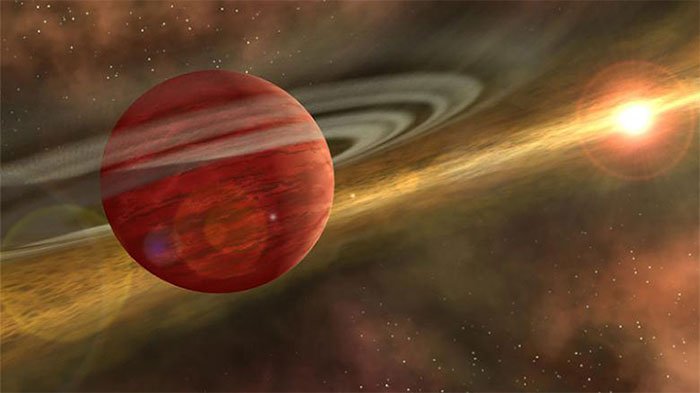Detecting the planet is forming
The Rochester Institute of Technology announced the discovery of a young planet 10 times heavier than Jupiter, only 330 light-years from Earth.

Graphic simulating gas planet 2MASS 1155-7919 b.(Photo: CNN).
Most exoplanets discovered by astronomers have been fully formed after millions of years of surrounding matter accumulation by gravity. But the new discovery, 2MASS 1155-7919 b , is a very young planet, thought to be still in the middle of accretion.
2MASS 1155-7919 b, only 330 light-years from Earth, is in the group of Epsilon Chamaeleontis stars visible in the southern sky. It is 10 times heavier than Jupiter and orbits a star about 5 million years old, a thousand times younger than our Sun.
What is unusual is that the planet's orbit lies very far away from the host star, 600 times the distance from the Earth to the Sun. This number is expected to change when the formation process is complete and only future observations will help scientists know how far the final distance between 2MASS 1155-7919 b and its star is. .
The discovery, made based on data from the European Space Agency's Gaia telescope, not only helps astronomers study the formation of giant gas planets, but also provides insights. more about their wide orbits. The findings have been published in the Research Profile of the American Astronomical Association.
- First shot of the planet is formed
- Discover a newly formed planetary system in the universe
- Video: Planet like Earth is forming
- For the first time, a photo of a planet is forming
- Detecting water on a distant planet
- Detecting traces of origin forming groundwater on the surface of Mars
- Detecting Goblin dwarf planet redefines the Solar System
- Detecting the youngest alien planet
- The process of forming giant planets in the universe
- Discover a planet forming around two stars
- Detecting a temperate planet is easier than Earth
- Detecting water on the planet 179 light-years from Earth
- Detecting rocky planet resembles Earth
- Detecting water in a strange planet's atmosphere
 Van Allen's belt and evidence that the Apollo 11 mission to the Moon was myth
Van Allen's belt and evidence that the Apollo 11 mission to the Moon was myth The levels of civilization in the universe (Kardashev scale)
The levels of civilization in the universe (Kardashev scale) Today Mars, the sun and the Earth are aligned
Today Mars, the sun and the Earth are aligned The Amazon owner announced a secret plan to build a space base for thousands of people
The Amazon owner announced a secret plan to build a space base for thousands of people NASA's 'Ninth Planet' Shows Signs of Being Friendly to Life
NASA's 'Ninth Planet' Shows Signs of Being Friendly to Life  Which planet is the oldest and youngest in the Solar System?
Which planet is the oldest and youngest in the Solar System?  Breakthrough discovery of planet with more water than Earth
Breakthrough discovery of planet with more water than Earth  How would humans die when visiting other planets?
How would humans die when visiting other planets?  Habitable planet appeared next to Earth, but met with disaster
Habitable planet appeared next to Earth, but met with disaster  Chinese spacecraft discovers mysterious cubes on other planets
Chinese spacecraft discovers mysterious cubes on other planets 